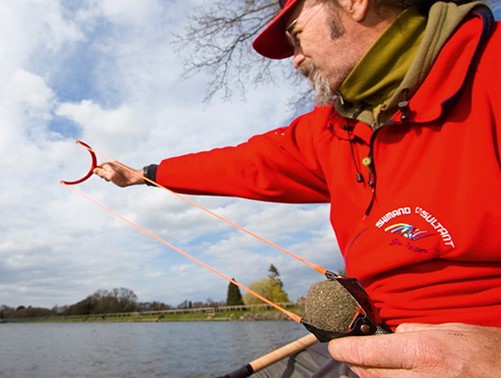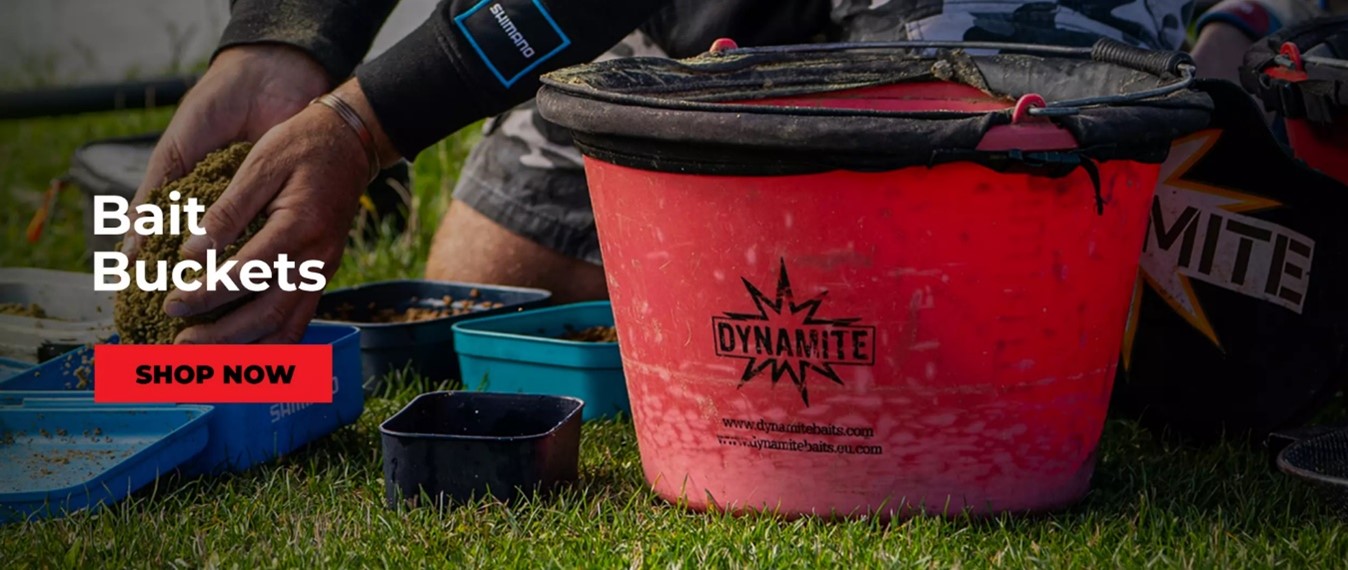Complete Beginner's Guide To Fishing Groundbait

The first thing to understand about groundbait is that there’s a varied menu on offer. Over the last decade we anglers have been spoiled by numerous manufacturers creating a multitude of types, flavours and colours, to give us a smorgasbord of options. Confused? Don’t worry, here’s the breakdown of not only what to look out for in choosing groundbait but how to mix it together too!
What is Groundbait?
Groundbait - A large chapter of the angler’s feeding bible, groundbait can be simple or it can be complicated – but getting to grips with it is a must.
Groundbait is a hugely effective part of any angler’s feeding skills set. From going through a feeder for bream to laying a bed down by hand for big carp, it’s something we should all know about and be confident using.
There’s a bit more to it than splashing some water over it and lobbing some into the lake, though. Groundbait can be as simple as a pile of soil from a molehill or as complicated as a finely blended mix of different types and colours to create a specific patch for fish to hold over. It can be used as a feed on its own or as a basic carrier to get your loose particles to where you want them.
There are different types of groundbaits, in ranging consistencies, along with many ways of mixing for specific techniques. It can all get a bit confusing. The first thing to do, then, is to get to grips with the kind of fishing you’ll be using groundbait for. For example, if you’re targeting roach on a clear river you’ll want a very different mix to the one you would use for fishing the Method for carp on a commercial.
Ask Yourself...
What is your aim for the groundbait?
Are you balling in by hand?
Is it going in a feeder?
Is it a natural venue?
Are you after carp or silvers?
Types of Groundbait for Fishing

Fishmeal: A great choice for carp, tench and bream, this stuff is produced, quite literally, from fish broken down into meal by drying the fish carcasses out and crushing them up. Fishmeal is the most common base ingredient in modern groundbaits and it is hugely effective. Fish love it and as it sits on the bottom – it’s relatively inert or inactive in the water – it leaches out plenty of scent to bring them into the feeding area.
Sweetcorn: Produced from, you’ve guessed it, sweetcorn (albeit dried and ground down) a sweetcorn groundbait is massively pungent delivering loads of scent into the water to draw fish in. Not so well used in the UK, it’s a favourite on the Continent and is great for bream and tench, as you’d expect. It’s also a great option for mixing up into a paste for on the hook too.
Crumb: This is old-school groundbait: cheap and solid, brilliant for bulking out a more expensive mix. It’s basically finely processed bread, so you can get it in brown or white varieties. It works as a feed on its own and you can also get it as punch crumb, which is less processed so is coarser and great to fish with breadpunch on the hook.
Active And Inert: Groundbait can have ingredients in it to give it different properties in the water. An active groundbait is more ‘active’ under the water – small particles such as hemp will pop and fizz around, delivering more in the way of scent and sight attraction. It’s great for species such as roach that feed up in the water and will flit around after the particles. On the other hand, when you want to present a bed of feed on the bottom for fish that feed there, such as bream or tench, an inert groundbait can often be better as it will sit there and leach out scent along the bottom, not up in the water.
Method: Designed specifically for the Method feeder these groundbaits are denser and claggier so that they cling to the frame of the feeder. This is important for standing up to the rigours of the cast and for when the carp start feeding off the feeder.
River: Due to the flow and often the depth of rivers, groundbaits designed to be used on these waterways are heavier and denser. This allows them to get down to the bottom before breaking up and to stay there longer instead of getting washed away in the flow. They are also usually quite pungent, the idea being to deliver a trail of food and scent downstream to bring feeding fish upstream to your swim.
Molehill Soil: A natural groundbait, molehill soil has been used by anglers for years. The reason for this is that it’s loaded with mole pooh, and with moles eating a lot of worms that means it’s also loaded with loads of attractive enzymes that fish love.
What is the Best Colour for Groundbait?
Look at any tackle-shop shelf bearing the weight of a mass of groundbait bags and you’ll see that there’s more than just your traditional biscuit-brown colouring to choose from. Red, yellow, black, green… there’s a lot of choices, but what you buy will depend again on what you want to use it for – so make sure you think before you part with your cash. Here are the main colour groups:
Black Groundbait
This is your natural-venue choice, especially in the winter months when there’s less colour hanging in the water. It works because of the way a fish works. To avoid being seen by predators, fish such as roach have dark backs to blend in with the bottom when looked at from above, and a white underside to blend in with the sky when viewed from below. So, put down a light-coloured groundbait for them to feed over in coloured water and they’re going to stand out – the exact opposite to what they want and a patch of feed that will make them very nervous, which is not what you want. Black, then, gives the perfect colour for fish to feed over, and the more they feed, the more you catch.
Brown Groundbait
The most common shade of groundbait, and for good reason. The majority of venues you will fish will a have a bottom that’s brown in colour – canal, lake, commercial or river. To make your swim seem as natural and appealing as possible then, a brown groundbait will blend in, delivering scent but not a colour patch that would raise suspicion.
Green Groundbait
Another natural colour that fish will be used to feeding over. Most green groundbaits will contain betaine, a derivative from sugar beet that when added to groundbait works to stimulate the fish appetite. Because of this, the majority of green-coloured groundbaits are aimed at anglers targeting carp, getting the species stimulated and feeding hard.
Red Groundbait
Red or orange are out-and-out visually stimulating groundbaits designed to not only deliver scent but be a beacon for fish to home in on. It is not designed for natural venues but is perfect for commercials where fish are hungry, competitive and on the lookout for the next swim to feed on. Because of this, it’s a particularly good bait for carp, tench and commercial barbel.

How to Mix Up Your Groundbait
Mixing up your groundbait is essential to making the most of it, and a bad mix will do you no favours. Watch the video below of how to mix your groundbait up or better yet, follow the step-by-step guide below:
1.) The first stage is to dry mix your groundbait. If you want to add different types together or, say, bulk out an expensive groundbait with some crumb, now’s the time to do it. Simply pour the amounts you require into a dry, round bowl or bucket and mix together by hand.
2.) Now it’s time to add water – but only bit by bit. If you slosh a load in at once all you’ll get is a load of soggy, overdamp groundbait in the middle surrounded by dry groundbait that hasn’t had a chance to absorb the wet stuff. Instead, use a bowl to dribble water into your main bowl while you mix by hand. This way you’ll get an even spread of moisture.
3.) You need to keep mixing until you’re sure that you’ve got a good, even texture throughout. What you don’t want are lumps, as these will cause your groundbait to break up unevenly and provide a large mouthful of food to the fish, which is exactly the opposite of what you want. This is also the reason that you need to use a round bowl for your mixing as it won’t have any corners that your mix can get lost in, resulting in overdamp or dry blobs.
4.) Don’t be in a hurry to throw your groundbait in yet. Rest it for a few minutes so that the particles can absorb the water properly. Because of this, it’s a good idea to make groundbait mixing the first thing you do when you get to your swim. You can rest it while you’re tackling up and once you’re ready to look at it again you can judge if it needs a bit more water to bind together properly.
5.) Test your mix first by grabbing a handful and squeezing it. Is it staying together properly? If not, is it too dry or too wet? Will it work for what you want to do with it? If not, you can add more water or more dry mix and go for it again.
6.) Look at any top-flight match angler and they’ll riddle their groundbait before using it. Not because it looks good, but because it works. Pushing your mix through a riddle breaks up any lumps, giving you a smooth and consistent mix.
7.) Once you get to this stage and you’re happy your mix is spot on for what you want to do with it you can now think about adding particles such as hemp, corn or caster. One thing to remember is to keep an eye on your mix throughout the session as it can dry out, meaning you might have to add a splash more water as you go.

This Piece was originally seen in:



